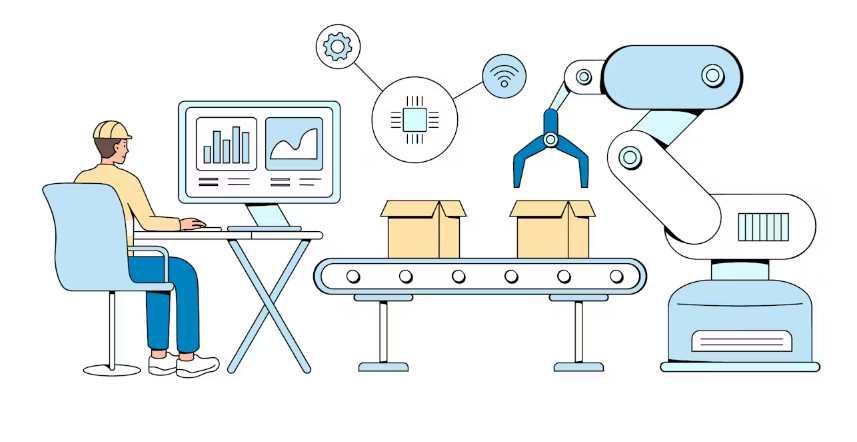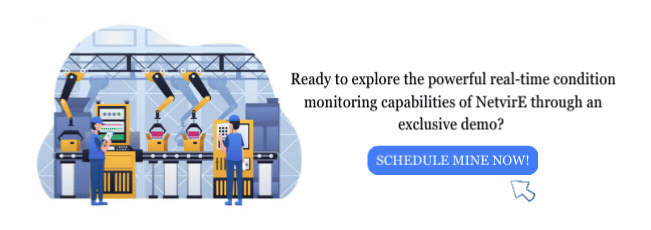There were times when predictive and proactive maintenance used to be seen as an option by many plant managers. Since they saw it as an option rather than a necessity.
However, times are changing, and now almost every industry is embracing it. As you’ve seen in the blog title, there’s a lot to discover about condition monitoring and why it’s becoming increasingly vital in this Industry 4.0 era.
As you’ve seen in the blog title, there’s a lot to discover about condition monitoring and why it’s becoming increasingly vital in this Industry 4.0 era.
So, let’s explore together and find out more about condition monitoring and why it matters so much!
If you have ever wondered how factories keep their machines running smoothly, condition monitoring (CM) is the secret sauce!
Condition monitoring is the process of continuously monitoring the health and performance of equipment or assets to detect any changes or anomalies that could indicate a potential fault or failure.
Moreover, it involves using various techniques such as data collection, analysis, and interpretation to assess the condition of machinery or systems in real-time or periodically.
So, the goal here is to identify issues early on, allowing for proactive maintenance and preventing unexpected downtime or failures.
And here’s the best part: When the condition monitoring system detects any machine health changes, it alerts the team. That way, they can jump in, assess the situation, and fix things fast.
Condition monitoring (CM) is a big step forward for many manufacturers. Moreover, it makes plants safer by closely monitoring equipment and detecting potential issues early.
What does this mean? Fewer unexpected breakdowns and better use of planned maintenance time to fix multiple issues simultaneously! In addition, it also saves money by avoiding unnecessary maintenance on machines that are still in good condition.
Though CM has been around for a while, its use is spreading to more and more industries. Top of all, CM systems offer great financial, operational, and safety benefits today.
Therefore, they’re reliable and effective across many manufacturing sectors. As a result, for manufacturers using CM, the risks are low, and the rewards are high.
CM helps you keep track of your machines and improve efficiency. To get the most out of condition monitoring, ask yourself:
Answering these can help maximize the benefits of condition monitoring for your operations.
If you want to dive into condition monitoring and build a proactive maintenance plan, here’s a quick guide to help you get started:
By following these steps, you can set up condition monitoring and keep your machines running smoothly.
Manufacturing facilities are the heart and soul of industrial businesses. Using proactive, predictive maintenance isn’t just smart for managing plants—it’s smart for business.
Right now, we’re only using 3 to 5% of the data we have to make important decisions. So, here, digitalization is the key to tapping into all the hidden information in your operations.
Therefore, by connecting data, insights, and self-learning models, you can increase efficiency and profitability, cut costs, and use your resources better.
Imagine proactively spotting machine issues before they create a problem. Consequently, this can lead to improvements that benefit the whole company, such as:
We can’t predict exactly when equipment will break down. When a machine fails, it can result in substantial losses, sometimes costing millions of dollars per day.
However, while we often focus on large, expensive machines, the smaller ones are equally crucial.
So, here, condition monitoring plays a key role by detecting issues early in both large and small machines, allowing for timely maintenance to prevent costly downtime.
Traditional methods relying solely on manual inspections or reactive maintenance can pose risks to factory workers.
Here, condition monitoring offers a safer alternative by providing continuous, remote machine health monitoring.
As a result, when maintenance needs are identified early, they reduce the risk of dangerous breakdowns and potential hazards.
Maintenance costs for each machine might seem small, but when you add them up across all machines, they become significant.
Therefore, by monitoring machine conditions effectively, even a 10% cost reduction per machine can make a big difference.
Consequently, this helps with better planning and prevents breakdowns before they happen.
Direct maintenance costs are easy to predict, but hidden costs can be up to five times higher.
So, to cut these costs, we need to shift from a reactive ‘fix it when it breaks’ mindset to a proactive approach facilitated by condition monitoring.
As a result, condition monitoring helps to identify and eliminate hidden expenses, making operations more efficient.
Like any significant change in operational strategy, the benefits of condition monitoring are substantial and well worth the effort.
In addition, it helps prevent major machine breakdowns, avoiding costly downtime, production loss, safety issues, and environmental impacts. Clearly, avoiding these vulnerabilities is crucial.
Since the Industrial Revolution, manufacturing has undergone three major advances:
Now, we’re entering the fourth phase, known as Industry 4.0.
In Industry 4.0, manufacturing processes will be digitally connected across the entire value chain using smart machines, remote sensors, and IT systems.
So, this phase promises greater efficiency, safety, and productivity, making the journey worthwhile.
IIoT plays a pivotal role here by enabling real-time data collection, analysis, and decision-making.
Moreover, by integrating IIoT with condition monitoring, manufacturers can achieve unprecedented levels of operational insight and control, transforming traditional maintenance into predictive and proactive strategies.
Also Read: What Is Remote Asset Management & How Does It Help Your Business Succeed?
With so many options out there, picking the right condition monitoring solution can be tough. That’s where NetvirE, developed by ThinkPalm, stands out.
Excited about NetvirE? Partner with ThinkPalm to explore condition monitoring and other salient features of NetvirE.
What are the five elements of Condition Monitoring (CM)?
Data collection, data analysis, alert generation, maintenance planning, and continuous improvement are the five key elements of condition monitoring.
What are the four pillars of Condition Monitoring (CM)?
The implementation of condition monitoring follows its four pillars: detection, diagnosis, prognosis, and program.
Why do we do CM?
To prevent unexpected equipment failures, minimize downtime, extend asset lifespan, and reduce maintenance costs.
What is the difference between predictive maintenance and condition-based monitoring (CbM)?
CbM detects current machine conditions, while predictive maintenance uses data to predict when maintenance will be needed to prevent failures.
Who uses CM?
Condition-based monitoring is crucial across various industries, including manufacturing, oil and gas, transportation, and food and beverage sectors.
What is an example of CM?
Monitoring vibrations in rotating machinery to detect imbalance or misalignment issues before they lead to equipment failure.